Case Studies
The Guardian
Ownership and funding
History of paper
The Guardian is an independent newspaper, established in 1983 for the purpose of presenting balanced coverage of events, and of promoting the best interests of Nigeria. It owes allegiance to no political party, ethnic community, religious or other interest group.
Owners/Trusts and funding model used
The Guardian is owned by Guardian Media Group, which has only one shareholder - the Scott Trust. The Scott Trust, named after our longest serving editor, CP Scott, exists to secure the financial and editorial independence of the Guardian in perpetuity.
Circulation figures
Daily Circulation- Around 105,134
Advertising Costs
5,000-80,000
Sales figures for last 5 years
Alternative Revenue Options
Rich people donating money
Online Options: Revenue
Option to subscribe or donate
Changes in last 10 years (distribution, price, format, technology) and effect on circulation and audiences
Cover prices have increased, they've gone online, app edition, circulation figures have dropped
Ideologies, Values and Regulation
Mission statement or principle
"Our values were set out by CP Scott in his centenary leader in 1921. They are: honesty, integrity, courage, fairness, and a sense of duty to the reader and the community. Our values and behaviours provide the basis of how we work together, how we communicate and what we should expect from each other.".
News Values it Prioritises
"We foster a supportive and open culture. We are curious and innovative, prepared to fail and willing to learn. We embrace diversity, champion inclusivity and treat everyone with respect".
Political Bias (previously and now)
The Guardian has always been a left-wing publication throughout its history, as they have stated in various articles. In review, story selection favours the left but is generally factual. They utilize emotionally loaded headlines.
Reporting Style
Need to report on different cultures, perspectives and community services.
Which body it's regulated by
The Guardian have established their own independent complaints systems instead. IPSO regulates more than 1,500 print titles and more than 1,100 online titles, including most of the UK's national newspapers.
Target Audience Research
Demographics- 50% female, average age 55+, 75% ABC
Psychometrics- Explorers, reformers and succeeders
Hobbies/Interests- Progressives who are interested in culture, travel and embrace technology and change
Issues they would be aware of-The newspaper is considered to be part of the “quality press” – a group of national papers which focuses on hard news rather than the sensationalism of tabloid journalism.
What they do with their disposable income-
How they access the media-
Films/Docs/Magazines/Music/Sites they like-
Types of stories that would appeal to them-
The Guardian Online
-theguardian.com was launched in 2008, developed from earlier website GuardianUnlimited that began in 1999.
-Combined with their print paper and The Observer, GMG ave risen to become the third largest newspaper in the world.
-Has roughly 34.7million monthly global users and country specific online versions in Australia + USA
GMG offer theguardian.com content on 4 platforms:
-Desktop
-Mobile
-Tablet formats
-Social media
These are also platforms for marketing The Guardian brand.
2017 digital revenues demonstrates the success of the online model:
-Digital revenue of £108.6
-An increase of 15% in 2017
-50% of GMG revenue
Readers can subscribe to digital editions from £11.99 a moth with additional options to access further content.
Production
-Online version of paper retains same liberal, progressive values as the print version.
-Website offers additional features like the Opinion section + Soulmates, which enable a greater range of content than print version.
-theguardian.com is a core news website made up of niche sections covering subjects like business, entertainment, technology, arts, sport and media.
-There is a rolling news service that is constantly updated by journalists.
Distribution
-theguardian.com is digitally distributed across digitally converged platforms.
-Reduces distribution costs and enhances profit from advertising.
-theguardian.com has a global reach and has country specific versions in the USA + Australia.
-theguardian.com content is also distributed through a partnership deal with Yahoo with users from Uk, USA, Australia, India andSingapore accessing content.
Circulation
-Since 2015, theguardian.com has increased circulation by 25%.
-It has 34.7million monthly global users.
-1.15million users access theguardian.com by mobile or tablet.
Regulation
-As a self-regulating publication, it is the role of the Readers' Editor to regulate both print and online content.
-theguardian.com has a global reach of 140million online users. Therefore regulating and responding to all isn't possible.
In deciding which complaints to prioritise, they use the following criteria:
-How serious the complaint is.
-The likelihood that harm could occur.
-The potential the content has to mislead.
-The proximity of the person to the issue raised and whether it directly affects them.
-How many have complained about the same feature.
-The risk to the reputation of GMG and their brands.
The Daily Mail
Ownership and funding
History of paper
The Daily Mail is a British daily middle-market tabloid newspaper and news website. It was founded in 1896 by Alfred Harmsworth, later 1st Viscount Northcliffe. Its roots can be traced to the Hull Packet, which was merged with the Hull Evening News in 1884 and 12 years later moved to London and became the Daily Mail. The Mail was originally a broadsheet but switched to a compact format on 3 May 1971, the 75th anniversary of its founding. Its sister paper The Mail on Sunday was launched in 1982, while Scottish and Irish editions of the daily paper were launched in 1947 and 2006 respectively.
Owners/Trusts and funding model used
-DMGT and DMG media own the daily mail. It is also owned by Jonathan Harmsworth. He is the current chairman and controlling shareholder of DMGT.
-Owned by the Rothermere family for over 100 years.
-Jonathan Harmsworth is viscount Rothermere.
Circulation figures
Circulation figures 1,264,810
Advertising Costs
£300-3 million +
Alternative Revenue Options
Adverts
Online Options: Revenue
Subscribers, adverts
Changes in last 10 years (distribution, price, format, technology) and effect on circulation and audiences
Gone online, circulation decreased, cover price increase
Ideologies, Values and Regulation
Mission statement or principle
"We prioritise organic investment and continuing our commitment to real dividend growth."
News Values it Prioritises
Negativity, personalisation, elite nations and people.
Political Bias (previously and now)
Right wing historically and present.
Reporting Style
Finding hard and soft news stories.
Which body it's regulated by
IPSO.
Target Audience Research
Demographics- According to the brand report from the Audit Bureau of Circulations (ABC), the Daily Mail shifts an average of around 960,000 copies per issue. This is a combination of the print and digital editions. 59% of readers are female with an average age of 59 years old. Majority of readers live in the South East.
Psychographics- Mainstream, resigned and succeeders. The Daily Mail claims to be “in touch with the hearts and minds of Middle England” because it engages with the “concerns, hopes and lifestyles of this powerful audience”. Their typical reader has strong spending power and would consider themselves to be “adventurous”.
Hobbies/Interests-
Issues they would be aware of-
What they do with their disposable income-
How they access the media-
Films/Docs/Magazines/Music/Sites they like-
Types of stories that would appeal to them-
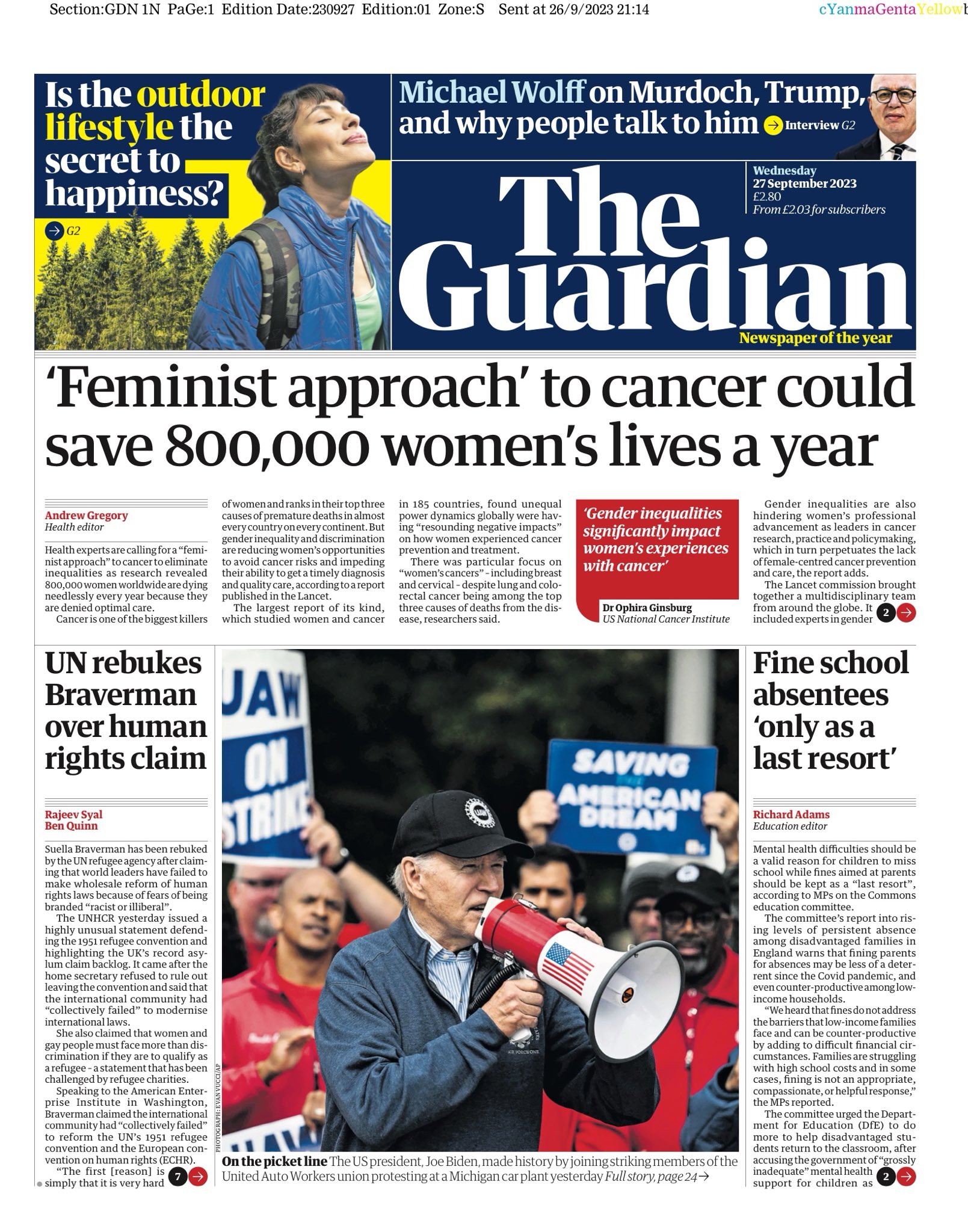
-Female on cover=feminism.
-Article about woman human rights claim.
-Joe Biden, goes against what Guardian normally does.
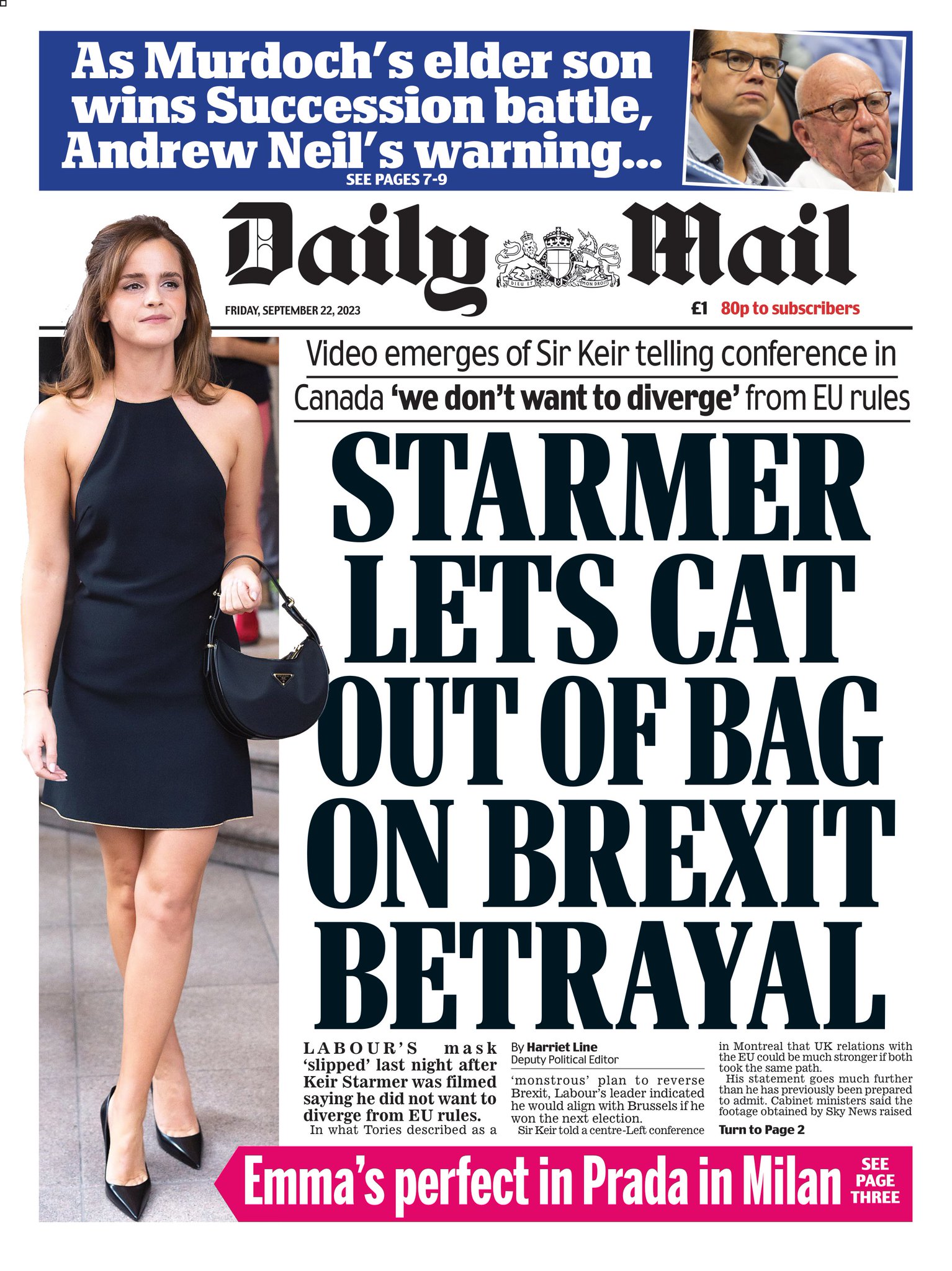
-Pretty actress on front 'perfect'.
-Starmer=negatively portrayed by making him appear as a rule breaker.
-Stereotypical woman sexualised shows ownership of men.
-Article on Andrew Neil, a white man.
-Political bias against labour.

-Has diversity and representation of other countries-informative.
-Whole cover has this focus rather than a range of topics=sympathetic.
-Left wing with honest views .
-Got rid of lifestyle and insight articles but they were removed on this which shows ownership because they have the freedom to edit the paper how they like as they are self regulated.
MailOnline
Statistics
-MailOnline was launched in 2003 + rebranded as a separate site in 2006. Combined with print paper, DMGT has 20.1% share of the market.
-DMGT has adapted their paper to consumer preferences and has been successful in capitalising on new income revenues through their digital content.
-They offer MailOnline content on 4 different platforms: desktop, mobile, tablet formats, social media. There are also different advertising platforms.
-Unlike some papers, digital advertising is profitable for the MailOnline. In 2017, the MailOnline's combined revenue was £119 million, an increase of £93 million from 2016.
-Shows success of online brand. They can remain competitive and have not had to introduce a paywall for online readers.
Production
-The content on the website is exclusively for the MailOnline and is not published in the print version.
-The MailOnline employs over 800 people who post over 1,500 articles and 560 videos a day.
-Although separate, with a different editor, it retains the same conservative news values.
-Content features a broad mix on international news and mainly UK-focused coverage of sports, finance and travel.
-Entertainment, celebrity and lifestyle news is a major component and the site is dominated by images.
Distribution
-The MailOnline is digitally distributed across converged platforms (website, apps and social media).
-Has Snapchat content.
-Reduces distribution costs and enhances profit from advertising.
-Enables a global reach for the brand through their online content in the UK, USA, Australia & India.
-Allows the brand to attract younger audiences than the print newspaper.
Circulation
-Since 2015, the MailOnline is considered to be the most visited English language news website in the world.
-Approximately one third of its daily traffic comes from the USA and Australia.
-The MailOnline has 15million users accessing its content daily.
-It has 10million Snapchat readers daily.
-The Facebook page has 1 billion monthly video views.
Regulation
-As a member of IPSO, readers can complain regarding content written by the MailOnline on any of its online platforms.
-Since 2015, IPSO has received 39 complaints against the MailOnline. Only 2 of these were upheld.
-IPSO can only regulate content produced by the MailOnline journalists-given the participatory nature of the platforms, much content isn't regulated.
-The MailOnline journalists are tasked with filtering, editing and removing content deemed offensive on their platforms, but the volume of user-generated content makes this difficult to do successfully.
-This suggests a conflict between the impact of online news on the regulation of the MailOnline content:
-Minimal Impact: although there is more room for invading privacy or publishing inaccurate information, given the gossipy nature of the news site, this can be regulated if it is posted by their journalists.
-Significant impact: sharing, commenting and often anonymous participation on content is encouraged. This is largely self-regulated and the success is debatable.
The MailOnline content is accessed by almost 13million daily browsers across its platforms.
Their readers can be identified by the following demographics:
-73.3& aged 35+
-26.7% aged 15-25 (print is 9.5%)
-Most visits from ABC1 group
DMG argues their success is due to a consistent application o core principles, defined as:
-creating addictive & timely content
-Using data and analytics effectively
-making front door traffic & engagement a priority
-Reinforcing the Daily Mail brand
They also use:
-cheap, scalable video that tells stories originally
-content to drive direct traffic to desktop & mobile home pages
-discount codes
They use click streaming to analyse audience preferences. This can be seen through Editor's Six of the Best & Most Shared Right Now. These show the range f stories that appeal to their audience.
Desktop
-843,000 daily browsers
-6.5million monthly browsers
Mobile & Tablet
-3.6million mobile phone daily reach
-2.3 million 35+
-1.3million 18-24
-Smartphone reach is 2.9million daily
-Tablet reach is 775,000
Social Media
-FB page gas over 14million likes
-Most successful news brand is FB
-Approx 1billion video views per month of FB
-Twitter profile has 2.2million followers
-2nd most popular new brand on Twitter
-10million Snapchat followers daily
Case Study Revision
Monday 22nd April 2024
Daily Mail:
Funding and Revenue
-25% of market share
-Colour display advert costs £181 per single column cm
-Have offset losses by increased profit from MailOnline brand, increased cover price from 60 to 70p, and have closed Didcot printing facilities to reduce production costs.
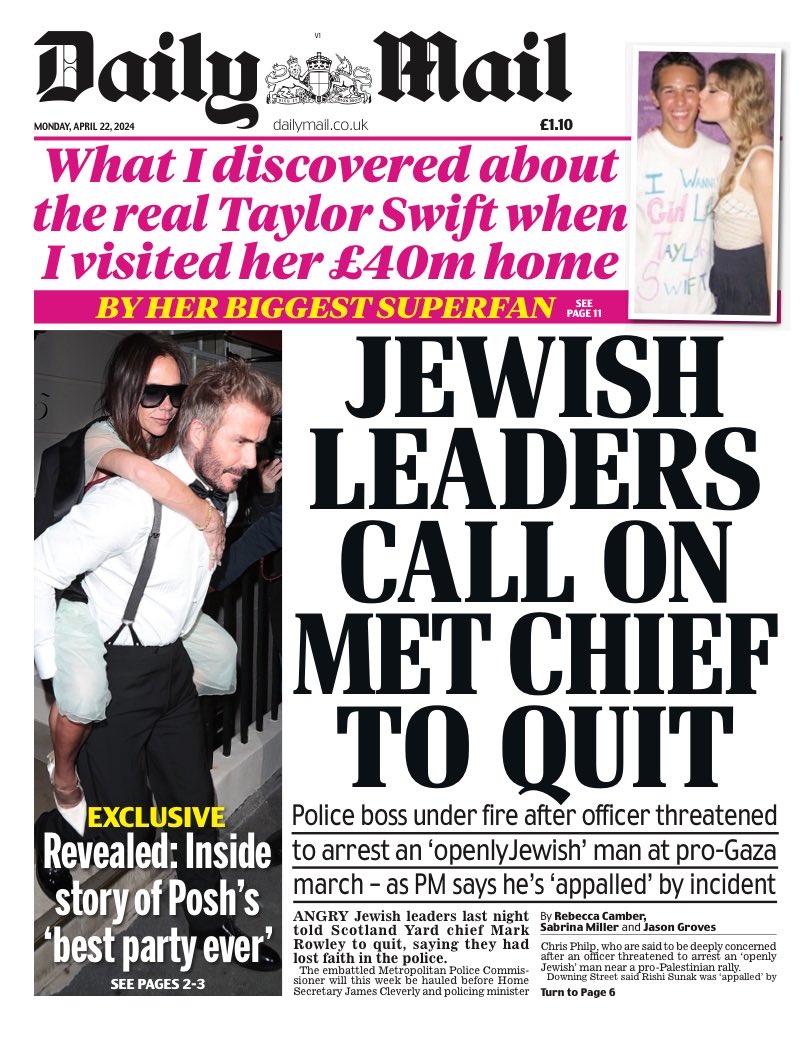

Logo: Refers to court of arms, connoting paper's honour and nationalistic values.
Plug: Left- Hairy Bikers Exclusive dishes connotes that the paper also shares things with its readers, thus valuing them.
Layout: Divided into 3. Top section identifies the brand, middle covers image & headline of lead story, bottom covers actual story. Layout anchors brand with main story and connotes that both have impact and are important. Lead story's size suggests political, social and cultural significance.
Sub-Heading: The sub-headings quickly summarise the story, connoting Daily Mail is succinct and reliable.
Headline:
Main Image: Left- David Beckham and Victoria, both famous celebs in Britain connoting nationalistic news takes priority despite the fact it is beside important international news. Right- Image of a woman who has written an article about her sex life, again prioritised soft news over the political headline beside it.
Minor Images: Left- Taylor Swift and a super fan
Byline: By Rebecca Camber-white woman, Sabrina Miller- white woman and Jason Groves- white man. Reinforces dominant hegemony of white, middle class.
Font & Colour:
Copy:
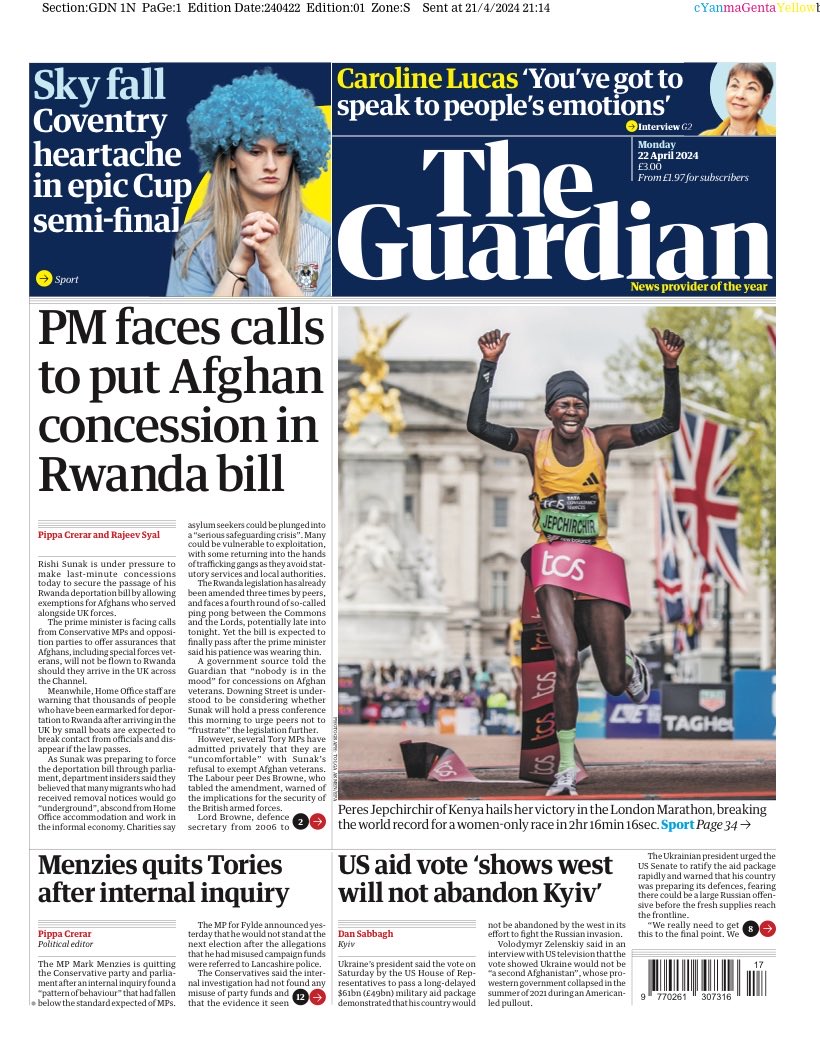
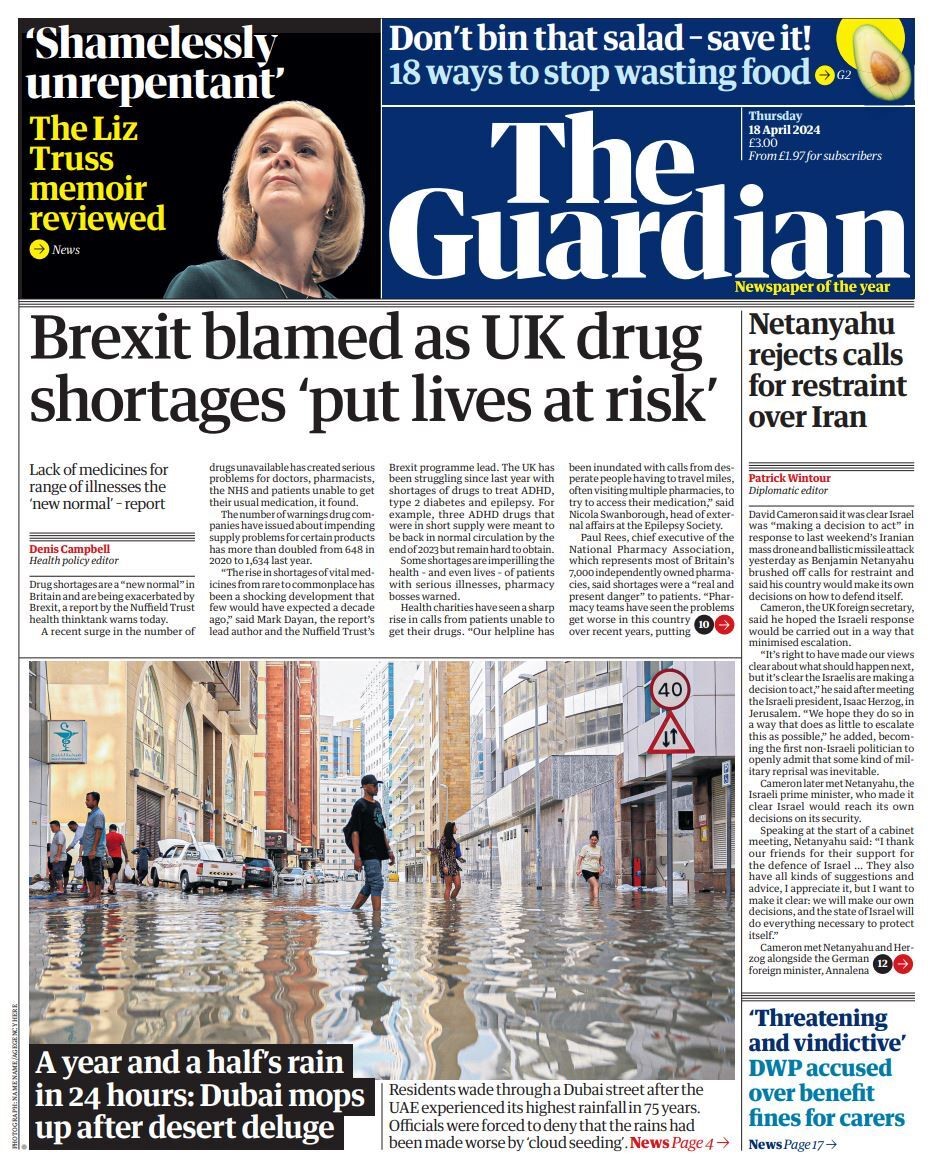
Masthead: The name 'Guardian' suggests protection and that fits well with the papers values.
Layout: Divided into 3, top section identifies brand, middle covers image, headline and story, and bottom covers other stories. Lead stories size suggests political, social and cultural significance.
Sub-heading: Quickly summarises the story, connoting they are reliable and succinct.
Headline: Hard news, relevant to audience.
Main Image: Union Jack in the background of left image connotes nationalistic views however they are showing diverse representations and multiculturalism through using a black woman being successful.
Minor Images:
Byline:
Font & Colour:
Copy:
Hall/representation- Black female subverts expectations and stereotypes
Tuesday 23rd April 2024
Banner: Includes masthead, same as paper, reveals the same as the paper, 'News provider of the year' advertising themselves. (Hesmondhalgh- risk- limited via promotion & award, C&S profit over creativity- goes against since it is about both creativity and profit.)Sign in, jobs, edition- interactive element for the audience, Shirky. not passive consumer but actually active engager)
Navigation bar: lots of options to click on, choice, options, variety for the audience, (Shirky) extensive content, Neale and mixing genres- lots of news, updated.
Headline, feature article also 'Live'- immediacy of news online is constant and evolving, Comments show engagement of audience, 5mins 2K comments, engagement of audience,





Comments
Post a Comment